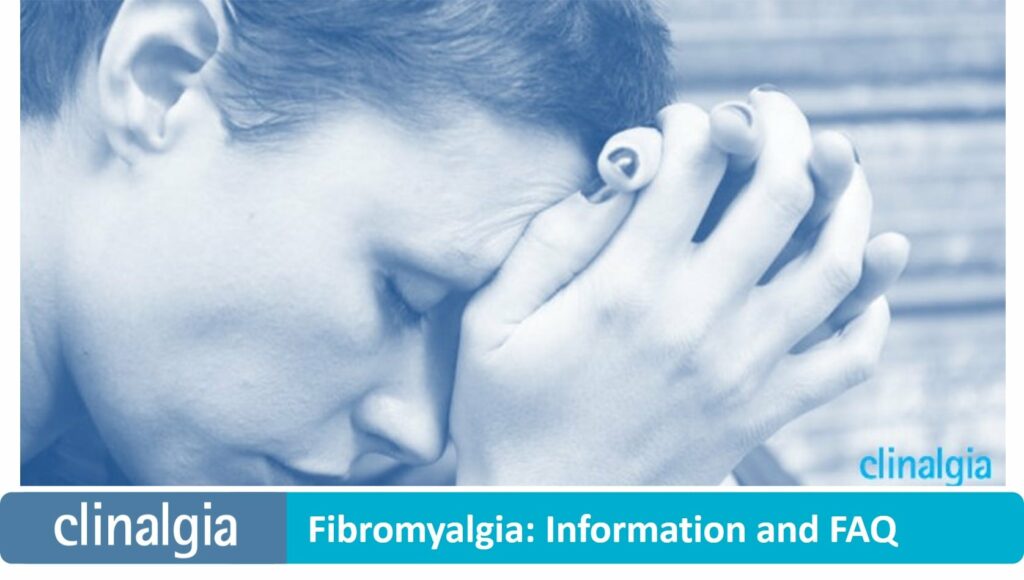
Fibromyalgia: Information and FAQ
Information about Fibromyalgia and Frequently Asked Questions (FAQ)
1.- What is fibromyalgia (meaning of the concept)?
The predominant symptom of fibromyalgia is the suffering of generalized musculoskeletal pain, a condition that is usually accompanied by a variety of symptoms such as headache, morning muscle stiffness and a feeling of constant fatigue.
How often does it occur?
It affects more women, occurring in 3.5% of adult women, and only 0.5% of men.
2.- How is fibromyalgia diagnosed?
The 2 diagnostic criteria are:
- a) History of generalized pain of at least three months of evolution.
It is considered generalized pain when the following characteristics are present:
-
-
- Areas of pain on palpation on both the right and left sides of the body.
- Areas of pain distributed both above and below the waist.
- In addition there may be axial pain: either along the cervical, thoracic or lumbar spine, or in the anterior region, in the chest.
-
- b) The pain will be clear and will be manifested when exploring by palpating the area with approximately 4kgr of pressure.
Other diagnostic factors include:
-
-
- Headache
- Irritable bladder (feeling of urgency to urinate).
- Dysmenorrhea (periods become irregular and painful)
- Excessive sensitivity to heat
- Tired legs
- Tingling or cramping sensation (especially in the hands and feet)
- Intolerance to physical exercise (especially when carrying weights, so that even your purse starts to get uncomfortable)
- Persistent fatigue
- Unrefreshed sleep
- Morning stiffness.
-
3.- What is the origin?
According to this model, there are individuals who are genetically predisposed to set in motion a cascade of neurological and hormonal responses in stressful situations in order to adapt to a series of circumstances. If these individuals with genetic vulnerability are subjected to a specific stressful situation or to the sum of several stressful situations, the adaptation system becomes saturated and fails.
Thus, there is often a specific identifiable episode in the patient’s life, such as the beginning of the development of a disease, an operation, an accident, a separation, but other times it is an accumulation of small stressors that are added until the glass is filled with one more drop.
The phenomena that we observe in fibromyalgia could be the clinical manifestations of this failure in the adaptation system.
The different stressors that can cause the system to fail can be of a very varied nature:
1.- biomechanical factors: joint hypermobility, orthopedic problems (one leg shorter than another, a malocclusion), trauma, postural problems (spinal deviation) and musculo-articular overload, etc.
2.- Biochemical factors: Exposure to toxic substances, lack of production of a substance by the organism, infectious processes (especially viruses), allergic reactions, etc.
3.- Psychological factors: poor ability to cope with stressful situations, depression, anxiety.
4.-How is fibromyalgia treated?
It is evident that fibromyalgia is an ailment whose etiopathogenesis seems to be multifactorial.
This means that the causes, far from being clear, are multiple and interrelated. Therefore, and in accordance with the most recent publications, we believe that the therapeutic approach to this type of patients should be multidisciplinary, resulting in the articulation of a team as perfectly as possible.
It is this idea that determines our service of clinical management of fibromyalgia syndrome. Once the respective specialists have ruled out an obvious organic cause, and fibromyalgia is diagnosed, the patient who is treated in our center is evaluated together to establish a strategy, which will be personal in each case, and that according to the evolution will be increasingly shaped.
Treatment team
The team we propose is composed of qualified medical, physiotherapeutic and psychological staff. It often happens that pharmacotherapy is not entirely sufficient to control pain suffering, imposing in these cases the complement with other therapies, and each patient will benefit more from a particular therapeutic approach.
Patient education
The education of fibromyalgia patients can be the cornerstone of their well-being, and concepts such as postural hygiene, ergonomics at work, physical and respiratory education, training in anxiety control techniques, etc., can make the difference between despair and happiness. We therefore propose a work protocol based on a joint vision of the problem, but where each area is evaluated specifically by a specialist.
Treatment according to illnesses
If, for example, the patient suffers from chronic daily headache, it will have to be diagnosed and treated in the most appropriate way, based on headache diaries, analog scales and pain topography. And if temporomandibular pathology manifests itself as primary, this would mark the beginning of treatment.
Likewise, if an anxious-depressive process dominates the picture, its therapeutic priority will have to be established, with pharmacology and psychological support. Using scales and tests we can measure the states of depression, anxiety and pain. Through the use of diaries we receive continuous information about the patient’s way of life and its physical-emotional implications.
All this information is evaluated and agreed upon as a team, and also with the patient himself, in search of a global improvement. It is, in short, a joint work so that in the face of an ailment such as fibromyalgia, sometimes quite limiting, a series of alternatives can be deployed in favor of a better quality of life.
Today we can say that the efforts that are being made are increasingly greater in this regard, but the disease itself cannot be cured. It may seem a bit harsh, but there are ways to act. With a team of professionals and with the patient himself, actions can be deployed to improve his quality of life and try to slow down the evolution of the process.
The fibromyalgic patient has to be «carried between cotton wool», and we believe that he/she needs a team of medical, psychological and physiotherapeutic professionals that, perfectly assembled, not only result in the improvement of the patient but also in the maintenance of the achievements made.
Fibromyalgia Support Institute
Clinalgia supports fibromyalgia through the Fibromyalgia Support Institute (IAF). The objective of the IAF is to coordinate resources and be a facilitator of the different projects and activities that can be projected and organized around fibromyalgia and involve the population affected by the disease to give them support. Get to know us!
5.- Fibromyalgia Manual or Decalogues
From Clinalgia the first manuals and decalogues of fibromyalgia for primary care medical patients and pharmacists were made.
- Manual para pacientes y médicos de fibromialgia Fibromyalgia manual for patients and physicians.Decálogo de fibromialgia para farmacéuticos
- Fibromyalgia Decalogue for Pharmacists
- Recomendaciones sobre la fibromialgia para pacientes
- Fibromyalgia Recommendations for Patients

Dr. Fco. Hidalgo Tallón, director of Clinalgia and of the Chair of Ozone Therapy and Chronic Pain of the UCAM, member of the Institute of Neurosciences of the UGR.
Our objective is to deploy a series of alternatives in favor of a better quality of life for patients suffering from chronic pain, once any organic cause that justifies it has been ruled out. We carry out a joint work between patient and professionals, in addition to establishing in each case a specific prevention program for each disease.
-
-
- Migraines
- Lumbalgia / Cervicalgia
- Headaches and Migraines
- Whiplash
- Craniomandibular Dysfunction
- Sleep Disorders
- Myofascial Pain
- Cluster Headaches
- Buccofacial and Oral and Dental Pain
- Fibromyalgia
-
We are here to help you, contact us without obligation.



